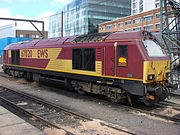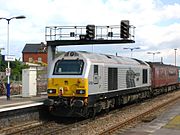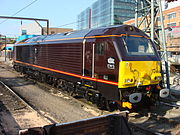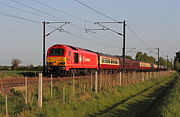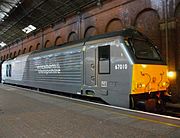- British Rail Class 67
-
"Class 67" redirects here. For the Norwegian EMU, see NSB Class 67.
British Rail Class 67 67004 on a rail head treatment train (Oct. 2009) Power type Diesel-electric Builder Meinfesa: Alstom, Valencia, Spain[1] Model JT-42-HWHS[2] Build date 1999–2000[2] Total produced 30[3] UIC classification Bo'Bo'[3] Gauge 1,435 mm (4 ft 8 1⁄2 in) Standard gauge[3] Wheel diameter 965 mm (3 ft 2.0 in)[2] Minimum curve 75 m (3.7 ch)[2] Wheelbase bogie wheelbase : 2.80 m (9 ft 2 in)[2]
bogie pivots : 11.63 m (38 ft 2 in)[2]Length 19.71 m (64 ft 8 in)[2] Width 2.71 m (8 ft 11 in)[2] Height 3.93 m (12 ft 11 in)[2] Locomotive weight 88 tonnes[3] / 90 tonnes[2] Fuel capacity 5300 litres[3] / 4927 litres[4] / 5460 litres[2][contradiction] Prime mover EMD 12N-710G3B-EC[3] Alternator EMD AR9AC6HEX[3] Traction motors EMD D43FM[3] Multiple working with UK classes59, 66[1] AAR system[citation needed] Top speed Design speed : 200 km/h (124 mph)[3] Power output Engine: 3,200 bhp (2,386 kW) @ 900rpm[3]
At rail: 2,500 hp (1,864 kW)[citation needed]Tractive effort Maximum: 144 kN (32,000 lbf)[3]
Continuous: 92 kN (20,700 lbf) @ 75km/h[3]Train heating Electric Train Supply (index: 66 / 330 kW)[5] Locomotive
brakeforce780 kN (78 LTf)[2] Train brakes Electropneumatic[3] Career EWS / DB Schenker UK Number 67001–67030[2] Nicknames Skips, Buckets, Cyclops Axle load class Route availability 8[2] Current owner Angel Trains[4] The Class 67 locomotives are a class of Bo'Bo' diesel electric mainline locomotives which were built for the English, Welsh and Scottish Railway between 1999 to 2000 by Alstom at Meinfesa in Valencia, Spain with drive components (engine and transmission) from General Motors Diesel.
Rail enthusiasts have nicknamed the class 'skips'.
Contents
History
Design, testing and introduction
Thirty locomotives were ordered in a £45million contract split between Alstom and General Motors.[6] for use by the English, Welsh and Scottish Railway (EWS) as British Rail Class 47 replacements for use on high-speed mail trains and passenger trains.[1] The locomotives were obtained on a 15 year lease via Angel Trains.[1]
The bodyshell is a monocoque load bearing Alstom design,[1][7] the bogies are an "H" frame Alstom design,[1] The engine, traction motors and control electronics are GM-EMD products, and the same as used in the British Rail Class 66. Unlike the Class 66, the traction motors are frame mounted rather than axle hung to reduce unsprung mass and the gear ratio is increased allowing higher speeds.[1] The cab design has a central driving position.[7]
The locomotives are able to supply electric head end power for passenger train heating and air-conditioning, and are equipped for buffer and screw coupling and also coupling via a buckeye coupler attached on a swing arm mount.[7]
High speed running tests were undertaken with 67002 starting at Alstom's facility at La Sagra (Toledo, Spain) and running on the standard gauge Madrid-Toledo high-speed rail line,[7] a top speed of 143 miles per hour (230 km/h) was obtained.[1]
The first locomotive to be delivered was 67003, which arrived in October 1999. Initially plans were for a rapid acceptance into service, but problems with the locomotives being slightly out of loading gauge[1] caused delays. Acceptance trials began in December, and all 30 units had been delivered to the UK by early 2000.[7]
The high axle load of the locomotive caused an initial speed restriction to 110 mph (177 km/h) and modifications to the bogies were required; locomotive 67023 was passed for 125 mph (201 km/h) running in July 2001,[8] all 30 units had been modified for 125mph running by June 2003.[9]
Operators
Initially the class were used primarily on mail trains.[10] EWS's contract with Royal Mail was terminated in 2003.[11]
The locomotives have since been used for First ScotRail on the Caledonian Sleeper on non electrified beyond Edinburgh, as "Thunderbird" rescue locomotives for failed trains on the ECML, on some freight trains,and are hire for use on chartered tourist trains.[8][10] Two units are also used for the Royal Train.[8]
Four locomotives were also used by the Wrexham and Shropshire railway company until it ceased operating in January 2011.[12]
Locomotives are still being used by Chiltern Railways.[when?][citation needed]
Liveries and naming
The locomotives were initially painted in EWS maroon livery.[7] In 2003 two locomotives, 67005 and 67006 replaced the two previous Class 47 locomotives for hauling the prestigious Royal Train;[13] these were repainted in the Royal Claret colour, with one unit named Queen's Messenger officially unveiled in 2004.[14] The other vehicle was named Royal Sovereign in February 2005.[15]
Unit 67029 'Royal Diamond' was re-liveried in silver for the EWS Executve Train.[when?][16] In January 2010 unit 67018 was repainted in a one-off Canadian National Red[16][unreliable source?] livery with a special white maple leaf (and DB Schenker logo) in honour of Canadian born former EWS and DB Schenker UK chairman Keith Heller.[16][17].
Other liveries carried include the "Wrexham & Shropshire" livery.[18], and Arriva Trains Wales livery.[19][unreliable source?]
Original EWS liveryEWS 'company train' liveryRoyal Train liveryDB Schenker modified liveryWrexham & Shropshire liverySee also
- The Israel Railways JT 42BW and RENFE Class 333.3 are a similar design
- Vossloh Euro 4000 - Related locomotives built at the same factory (former Alstom Valencia plant)
References and sources
References
- ^ a b c d e f g h i "Class 67". www.semgonline.com. Southern E-Group. http://www.semgonline.com/diesel/class67_1.html.
- ^ a b c d e f g h i j k l m n "Technical". the67depot.webs.com. The 67 Depot. http://the67depot.webs.com/technical.html.
- ^ a b c d e f g h i j k l m Diesel-Electric Locomotives Class 67 data sheet vossloh-espana.com
- ^ a b "67 - GM Diesel Electric Locomotive". www.angeltrains.co.uk. Angel Trains. http://www.angeltrains.co.uk/en/fleet-portfolio/data-sheets/view/25-gm-diesel-electric-locomotive. Retrieved 11 August 2011.
- ^ "Class 67 Diesel Photo Gallery - Class Info". www.class67.co.uk. The Class 67 Diesel Photo Web Site / Colin Birch. http://www.class67.co.uk/cl67info.htm.
- ^ The Railway magazine, Volume 150. IPC Business Press. 2004. p. 12. http://books.google.co.uk/books?id=AzlWAAAAMAAJ.
- ^ a b c d e f "Class 67". www.therailwaycentre.com. The RailwayCentre.Com Ltd. http://www.therailwaycentre.com/Pages%20Loco/Recognition%20loco/Illus_67.html.
- ^ a b c Gareth McMurray. "rolling stock : class 67". www.thejunction.org.uk. http://www.thejunction.org.uk/cl67.html.
- ^ "EWS completes 125mph locomotive upgrade programme", www.ews-railway.co.uk (EWS), 26 June 2003, archived from the original on 23 February 2004, http://web.archive.org/web/20040223164054/http://www.ews-railway.co.uk/pages/displaynews.php3?storyid=286
- ^ a b Charlie Hume. "North Wales Coast Railway: Class 67". www.nwrail.org.uk. http://www.nwrail.org.uk/c67.htm.
- ^ "Mail trains to be scrapped". news.bcc.co.uk. BBC News. 6 June 2003. http://news.bbc.co.uk/1/hi/uk/2967564.stm.
- ^ Chris Milner (26 January 2011). "Wrexham & Shropshire to cease operation". www.railwaymagazine.co.uk. The Railway Magazine. http://www.railwaymagazine.co.uk/news/wrexham-shopshire-to-cease-operation.
- ^ Julian Holland (2007). Amazing and Extraordinary Railway Facts. David & Charles. pp. 81. http://books.google.co.uk/books?id=cP2XN4vSz3IC&lpg=PA81&vq=Class%2067&pg=PA81#v=onepage&q&f=false.
- ^ "New Royal Train locomotive unveiled", www.ews-railway.co.uk (EWS), 18 February 2004, archived from the original on 1 October 2006, http://web.archive.org/web/20061001000058/http://www.ews-railway.co.uk/cmsystem/news_article.asp?guid={33366DAD-CBE8-46E4-B35B-70AD3634A62A}
- ^ "HM The Queen names dedicated Royal Train locomotive at Bristol", www.ews.railway.co.uk (EWS), 25 February 2005, archived from the original on 1 October 2006, http://web.archive.org/web/20061001000153/http://www.ews-railway.co.uk/cmsystem/news_article.asp?guid={D5D0BADF-5617-4ACB-9379-5B94D81E7E5C}
- ^ a b c Waller, Mike (December 2010), "Skips for Hire", The Marlow Donkey (Marlow & District Railway Society) (131): 13–16, http://www.mdrs.org.uk/documents/donkey131.pdf, "exception is 67018 … this shade of red is not that of DB Schenker but rather that used by Canadian National on its locomotives … recognition that Mr Heller spent most of his career with CN"
- ^ "First DB-Schenker liveried Class 67 named Keith Heller", Railway Herald (208): 4, January 2010, http://www.railwayherald.org/magazine/pdf/RHUK/Issue208.pdf
- ^ "Wrexham & Shropshire", www.icrs.org.uk (Inter City Railway Society ICRS), http://www.icrs.org.uk/Site/Features/wrexham_shropshire.htm, retrieved 8 October 2011
- ^ "The News in Pictues", Railway Herald (285): 10, 26 September 2011, http://www.railwayherald.co.uk/magazine/pdf/RHUK/Issue285.pdf
Sources
- Fox, Peter; Hall, Peter & Pritchard, Robert (2004). British Railways Locomotives & coaching stock 2004. Sheffield: Platform 5. ISBN 1 902336 39 9.
External links
British railway locomotives and miscellany, 1948 to present Diesel shunters Diesel shunters
(pre-TOPS)Main-line diesels: Main-line diesels
(pre-TOPS)Electrics Electrics
(pre-TOPS)Departmental 97 · 97/6 · Eastern · Southern · Other Series
Prototypes Ships Categories:- British Rail diesel locomotives
- EMD locomotives
- Alstom Prima diesel locomotives
- Bo-Bo locomotives
- Railway locomotives introduced in 1999
- Macosa/Meinfesa/Vossloh Espana locomotives
Wikimedia Foundation. 2010.


